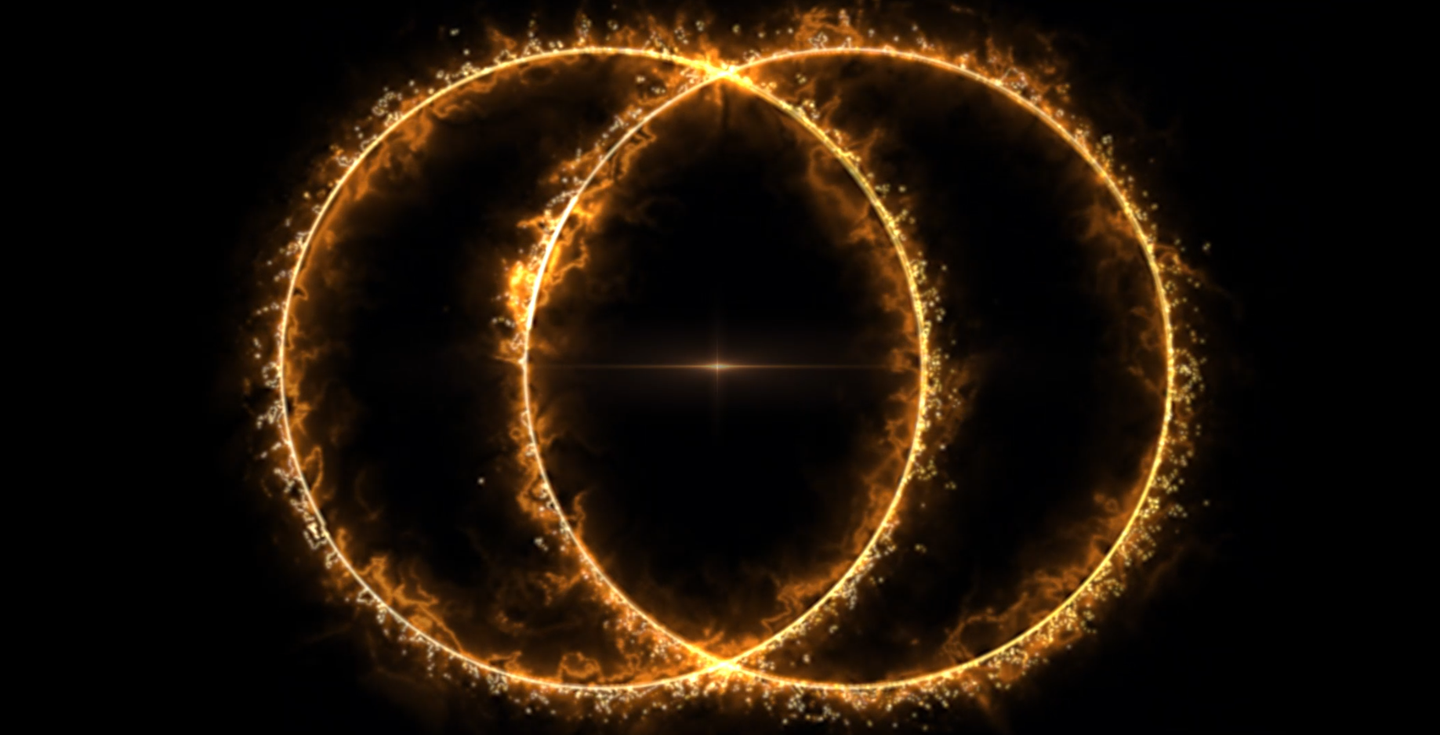Citizen scientists help spot massive ring-shaped radio galaxies
Citizen scientists and astronomers have discovered three vast ring-shaped radio sources—revealing how galaxies and black holes evolve together.

A still image from the animation of RAD J131346.9+500320.
(CREDIT: RAD@home Astronomy Collaboratory (India))
Three enormous and peculiar radio light rings were discovered far, far outside our own galaxy, shedding more light on one of the enigmas that have long perplexed astronomers.
The find was reported by the RAD@home Astronomy Collaboratory — a citizens science community that combines professional astronomers with amateur citizen volunteers who sift through vast radio sky surveys. Together, they have discovered three giant, ring-shaped radio sources, each different from anything ever before seen.
A New Cosmic Mystery
The brightest sources in radio astronomy are galaxies emitting twin beams of charged particles from supermassive black holes in the galaxies' cores. These jets construct lobes or hotspots that radiate radio waves. The newly found objects, dubbed Odd Radio Circles, or ORCs, don't follow that blueprint. They appear to be giant, faraway rings of radio emission that sometimes reach hundreds of thousands of light-years across — a ten to twenty times larger version of the Milky Way.
Since their first detection in 2019, ORCs have been confounding astronomers. They may be shockwaves produced when black holes crash into each other, collisions between galaxies, or possibly colossal particle flows known as "superwinds." One thing is certain: they're rare, dim, and easy to miss. Only in radio light do they radiate a ghostly glow, one which is imperceptible to ordinary telescopes.
The most breathtaking of the three new discoveries, called RAD J131346.9+500320, is situated nearly halfway through the universe, with a redshift of around 0.94. That is, the light that arrives on Earth departed when the universe was half its current age. It's also the strongest ORC that's ever been spotted, blazing nearly a hundred times more luminous than others that have been seen before.
Two Rings That Intersect
This is special in another aspect — it has not one, but two rings that intersect one another. There's only one other instance of one. The double configuration is approximately 800,000 light-years in size, and its radio emission decreases as the frequency increases, which is a sign that it's made up of aging plasma that's left over from a powerful blow in the ancient past.
Astronomers used the Low-Frequency Array (LOFAR), a large network of antennas across Europe. LOFAR, which works at frequencies between 10 and 240 megahertz, can detect faint radio waves from the distant past. It allows researchers to gaze back billions of years, when galaxies and black holes were just taking shape.
“This work shows how professional astronomers and citizen scientists together can push the boundaries of scientific discovery,” said Dr. Ananda Hota of the University of Mumbai, who founded the RAD@home network. “ORCs are among the most bizarre and beautiful cosmic structures we’ve ever seen – and they may hold vital clues about how galaxies and black holes co-evolve.”
Rings Born of Bent Jets
The other two finds are equally astonishing. One, named RAD J122622.6+640622, is a massive radio galaxy spanning nearly three million light-years — over 25 times the diameter of the Milky Way. One of its jets makes a sudden deflection and bends into a near-circle about 100,000 light-years in diameter.
The abrupt change may have occurred when the jet struck against dense material or encountered pressure gradients in its host cluster. That collision may have folded the plasma back upon itself, forming a radio loop. The ring is found on the outskirts of the galaxy's cluster, where environmental forces are most severe, and that makes it likely that its shape is the product of this cosmic tug-of-war.
The third discovery, RAD J142004.0+621715, boasts a thin jet ending in a bright ring of radio emission on the edge of its host galaxy. The structure is about 1.4 million light-years wide and sits at the core of a giant cluster of galaxies. The ring is about 60,000 light-years wide and glows where the jet crosses the hot plasma that fills the cluster, potentially blown up by pressure from outside.
Nearby, researchers also found a strange C-shaped structure, which might have been created when a second galaxy disrupted the jet. The dynamic cluster environment appears to shape both the ring and jet, adding another example of how the environment in the universe conditions what galaxies do.
The Role of Citizen Science
What is so interesting about these findings is who found them. The RAD@home Astronomy Collaboratory is not a traditional observatory. It's an internet-based community of students, researchers, and volunteers who study publicly available radio sky surveys on their home computers. They contrast data from various frequencies to look for patterns that automated algorithms might miss.
"Citizen scientists are still undefeated at finding peculiar patterns," added Dr. Pratik Dabhade of Poland's National Centre for Nuclear Research, a co-author on the paper. "These discoveries show that ORCs and radio rings are not isolated oddities. They're members of a shared family of plasma structures shaped by jets, winds, and the cosmic environment."
Since ORCs are so thin, programs simply ignore them. Human eyes, as it turns out, are still better at finding these ethereal rings. The collaboration between amateur and professional astronomers has raised the standard of how challenging data can be explored in the era of big sky surveys.
Clues to Galactic Evolution
What all three findings share in common is their environment. All three are located within a densely packed area — a galaxy cluster with around 100 trillion solar masses of material. That's a clue that the hot plasma surrounding these rings might play a huge role in forming them. The radio emission likely occurs due to relativistic electrons traversing magnetic fields in a synchrotron radiation process.
For the double-ring ORC, the form might be following the edge of a past outburst that has been weakening over millions of years. In the giant radio galaxy, the ring seems to be a consequence of a jet that was deflected. Maybe in the third case, the jet puffed up the ring as it played with the plasma in the cluster.
The upcoming next generation of radio telescopes, the Square Kilometre Array, will be far more sensitive and possibly will find thousands more of these ghostly rings. Paired with new optical surveys like the Vera C. Rubin Observatory and DESI, researchers will be able to match up the radio rings with their parent galaxies and explore how they evolve over cosmic time in the near future.
Dr. Hota states that these are a new frontier in radio astronomy. "The universe still has a lot of surprises for us," he said. "Thanks to citizens and with very new powerful tools, we're revealing structures that contradict what we thought we knew about galaxies."
Practical Implications of the Research
With the discovery of these radio rings, scientists have new potential for studying the interaction between black holes, galaxies, and the intergalactic medium.
These observations bring an understanding of how energy and matter move through the universe, forming galaxies over billions of years.
The project also shows the growing role of citizen science in modern research, proving that with proper tools and collaboration, anyone can push the limits of astronomy.
Research findings are available online in the journal Monthly Notices of the Royal Astronomical Society.
Related Stories
- Perfectly shaped cosmic bubble in space baffles astronomers
- Scientists discover 300 odd galaxies that shouldn't exist
- Euclid space telescope discovers Einstein Ring in a nearby galaxy
Like these kind of feel good stories? Get The Brighter Side of News' newsletter.
Joseph Shavit
Science News Writer, Editor-At-Large and Publisher
Joseph Shavit, based in Los Angeles, is a seasoned science journalist, editor and co-founder of The Brighter Side of News, where he transforms complex discoveries into clear, engaging stories for general readers. With experience at major media groups like Times Mirror and Tribune, he writes with both authority and curiosity. His work spans astronomy, physics, quantum mechanics, climate change, artificial intelligence, health, and medicine. Known for linking breakthroughs to real-world markets, he highlights how research transitions into products and industries that shape daily life.



